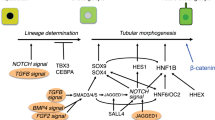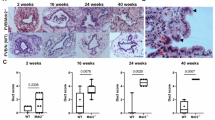Abstract
The ezrin-radixin-moesin (ERM) family of proteins crosslink actin filaments and integral membrane proteins1,2,3. Radixin (encoded by Rdx) is the dominant ERM protein in the liver of wildtype mice4,5 and is concentrated at bile canalicular membranes (BCMs)5. Here we show that Rdx−/− mice are normal at birth, but their serum concentrations of conjugated bilirubin begin to increase gradually around 4 weeks, and they show mild liver injury after 8 weeks. This phenotype is similar to human conjugated hyperbilirubinemia in Dubin-Johnson syndrome6,7, which is caused by mutations in the multidrug resistance protein 2 (MRP2, gene symbol ABCC2)8,9,10,11, although this syndrome is not associated with overt liver injury. In wildtype mice, Mrp2 concentrates at BCMs to secrete conjugated bilirubin into bile8,11,12. In the BCMs of Rdx−/− mice, Mrp2 is decreased compared with other BCM proteins such as dipeptidyl peptidase IV (CD26) and P-glycoproteins. In vitro binding studies show that radixin associates directly with the carboxy-terminal cytoplasmic domain of human MRP2. These findings indicate that radixin is required for secretion of conjugated bilirubin through its support of Mrp2 localization at BCMs.
This is a preview of subscription content, access via your institution
Access options
Subscribe to this journal
Receive 12 print issues and online access
$209.00 per year
only $17.42 per issue
Buy this article
- Purchase on SpringerLink
- Instant access to full article PDF
Prices may be subject to local taxes which are calculated during checkout





Similar content being viewed by others
References
Mangeat, P., Christian, R. & Martin, M. ERM proteins in cell adhesion and membrane dynamics. Trends Cell Biol. 9, 187–192 (1999).
Tsukita, Sa. & Yonemura, S. Cortical actin organization: lessons from ERM (Ezrin/Radixin/ Moesin) proteins. J. Biol. Chem. 274, 34507–34510 (1999).
Bretscher, A., Chambers, D., Nguyen, R. & Reczek, D. ERM-merlin and EBP50 protein families in plasma membrane organization and function. Annu. Rev. Cell Dev. Biol. 16, 113–143 (2000).
Sato, N. et al. A gene family consisting of ezrin, radixin, and moesin. Its specific localization at actin filament/plasma membrane association sites. J. Cell Sci. 103, 131–143 (1992).
Fouassier, L. et al. Ezrin-radixin-moesin-binding phosphoprotein 50 is expressed at the apical membrane of rat liver epithelia. Hepatology 33, 166–176 (2001).
Dubin, I.N. & Johnson, F.B. Chronic idiopathic jaundice with unidentified pigment in liver cells: a new clinicopathologic entity with report of 12 cases. Medicine 33, 155–179 (1954).
Sprinz, H. & Nelson, R.S. Persistent nonhemolytic hyperbilirubinemia associated with lipochrome-like pigment in liver cells; report of four cases. Ann. Intern. Med. 41, 952–962 (1954).
Kartenbeck, J., Leuschner, U., Mayer, R. & Keppler, D. Absence of the canalicular isoform of the MRP gene-encoded conjugate export pump from the hepatocytes in Dubin-Johnson syndrome. Hepatology 23, 1061–1066 (1996).
Büchler, M. et al. cDNA cloning of the hepatocyte canalicular isoform of the multidrug resistance protein, cMrp, reveals a novel conjugate export pump deficient in hyperbilirubinemic mutant rats. J. Biol. Chem. 271, 15091–15098 (1996).
Paulusma, C.C. et al. A mutation in the human canalicular multispecific organic anion transporter gene causes the Dubin-Johnson syndrome. Hepatology 25, 1539–1542 (1997).
Keitel, V. et al. Impaired protein maturation of the conjugate export pump multidrug resistance protein 2 as a consequence of a deletion mutation in Dubin-Johnson syndrome. Hepatology 32, 1317–1328 (2000).
König, J. et al. Conjugate export pumps of the multidrug resistance protein (MRP) family: localization, substrate specificity, and Mrp2-mediated drug resistance. Biochim. Biophys. Acta 1461, 377–394 (1999).
Tsukita, Sa. et al. ERM family members as molecular linkers between the cell surface glycoprotein CD44 and actin-based cytoskeletons. J. Cell Biol. 126, 391–401 (1994).
Yonemura, S. et al. Ezrin/radixin/moesin (ERM) proteins bind to a positively charged amino acid cluster in the juxta-membrane cytoplasmic domain of CD44, CD43, and ICAM-2. J. Cell Biol. 140, 885–895 (1998).
Reczek, D., Berryman, M. & Bretscher, A. Identification of EBP50: a PDZ-containing phosphoprotein that associates with members of the ezrin-radixin-moesin family. J. Cell Biol. 139, 169–179 (1997).
Hirao, M. et al. Regulation mechanism of ERM (ezrin/radixin/moesin) protein/plasma membrane association: possible involvement of phosphatidylinositol turnover and Rho-dependent signaling pathway. J. Cell Biol. 135, 37–51 (1996).
Takahashi, K. et al. Direct interaction of the Rho GDP dissociation inhibitor with ezrin/radixin/moesin initiates the activation of the Rho small G protein. J. Biol. Chem. 272, 23371–23375 (1997).
Lamb, R.F. et al. The TSC1 tumour suppressor hamartin regulates cell adhesion through ERM proteins and the GTPase Rho. Nature Cell Biol. 2, 281–287 (2000).
Paulusma, C.C. et al. Congenital jaundice in rats with a mutation in a multidrug resistance-associated protein gene. Science 271, 1126–1128 (1996).
Itoh, M. et al. The 220-kD protein colocalizing with cadherins in non-epithelial cells is identical to ZO-1, a tight junction-associated protein in epithelial cells: cDNA cloning and immunoelectron microscopy. J. Cell Biol. 121, 491–502 (1993).
Childs, S., Yeh, R.L., Georges, E. & Ling, V. Identification of a sister gene to P-glycoprotein. Cancer Res. 55, 2029–2034 (1995).
Denker, S.P., Huang, D.C., Orlowski, J., Furthmayr, H. & Barber, D.L. Direct binding of Na+-H+ exchanger NHE1 to ERM proteins regulates the cortical cytoskeleton and cell shape independently of H+ translocation. Mol. Cell 6, 1425–1436 (2000).
Nies, A.T. et al. Structural requirements for the apical sorting of human multidrug resistance protein 2 (ABCC2). Eur. J. Biochem. 269, 1866–1876, (2002).
Kocher, N. et al. PDZK1, a novel PDZ domain-containing protein up-regulated in carcinomas and mapped to chromosome 1q21, interacts with cMOAT (MRP2), the multidrug resistance-associated protein. Lab. Invest. 79, 1161–1170 (1999).
Doi, Y. et al. Normal development of mice and unimpaired cell adhesion/cell motility/actin-based cytoskeleton without compensatory up-regulation of ezrin or radixin in moesin gene knockout. J. Biol. Chem. 274, 2315–2321 (1999).
Kondo, T. et al. ERM (ezrin/radixin/moesin)-based molecular mechanism of microvillar breakdown at an early stage of apoptosis. J. Cell Biol. 139, 749–758 (1997).
Cui, Y. et al. Drug resistance and ATP-dependent conjugate transport mediated by the apical multidrug resistance protein, MRP2, permanently expressed in human and canine cells. Mol. Pharmacol. 55, 929–937 (1999).
Nies, A.T., Cantz, T., Brom, M., Leier, I. & Keppler, D. Expression of the apical conjugate export pump, Mrp2, in the polarized hepatoma cell line, WIF-B. Hepatology 28, 1332–1340 (1998).
Niwa, H., Miyazaki, J. & Smith, A.G. Quantitative expression of Oct-3/4 defines differentiation, dedifferentiation or self-renewal of ES cells. Nature Genet. 24, 372–376 (2000).
Matsui, T. et al. Rho-kinase phosphorylates COOH-terminal threonines of ezrin/radixin/moesin (ERM) proteins and regulates their head-to-tail association. J. Cell Biol. 140, 647–657 (1998).
Acknowledgements
We thank T. Noda for discussions and J. Yamane for preparing bile canalicular fractions. This work was supported in part by a Grant-in-Aid for Scientific Research (B) (to Sa.T.) and a Grant-in-Aid for Cancer Research (to Sh.T.) from the Ministry of Education, Science and Culture of Japan, and grants from the Deutsche Forschunggemeinshaft (to D.K.).
Author information
Authors and Affiliations
Corresponding author
Ethics declarations
Competing interests
The authors declare no competing financial interests.
Rights and permissions
About this article
Cite this article
Kikuchi, S., Hata, M., Fukumoto, K. et al. Radixin deficiency causes conjugated hyperbilirubinemia with loss of Mrp2 from bile canalicular membranes. Nat Genet 31, 320–325 (2002). https://doi.org/10.1038/ng905
Received:
Accepted:
Published:
Issue Date:
DOI: https://doi.org/10.1038/ng905
This article is cited by
-
ZO-2/Tjp2 suppresses Yap and Wwtr1/Taz-mediated hepatocyte to cholangiocyte transdifferentiation in the mouse liver
npj Regenerative Medicine (2022)
-
Neonatal Dubin–Johnson syndrome: biochemical parameters, characteristics, and genetic variants study
Pediatric Research (2021)
-
Multidimensional imaging of liver injury repair in mice reveals fundamental role of the ductular reaction
Communications Biology (2020)
-
Reduced Mrp2 surface availability as PI3Kγ-mediated hepatocytic dysfunction reflecting a hallmark of cholestasis in sepsis
Scientific Reports (2020)
-
Changes in Radixin Expression and Interaction with Efflux Transporters in the Liver of Adjuvant-Induced Arthritic Rats
Inflammation (2020)



